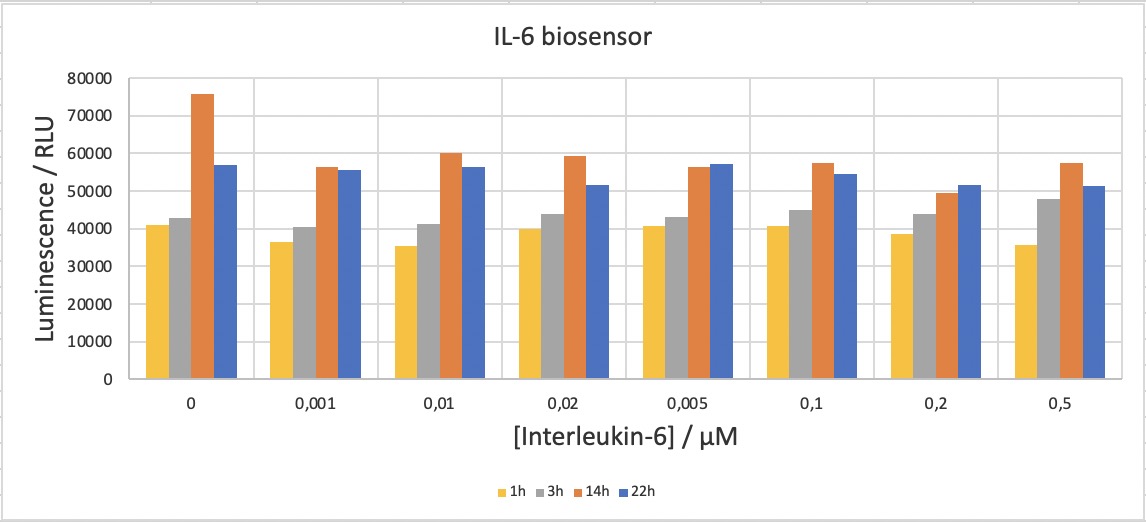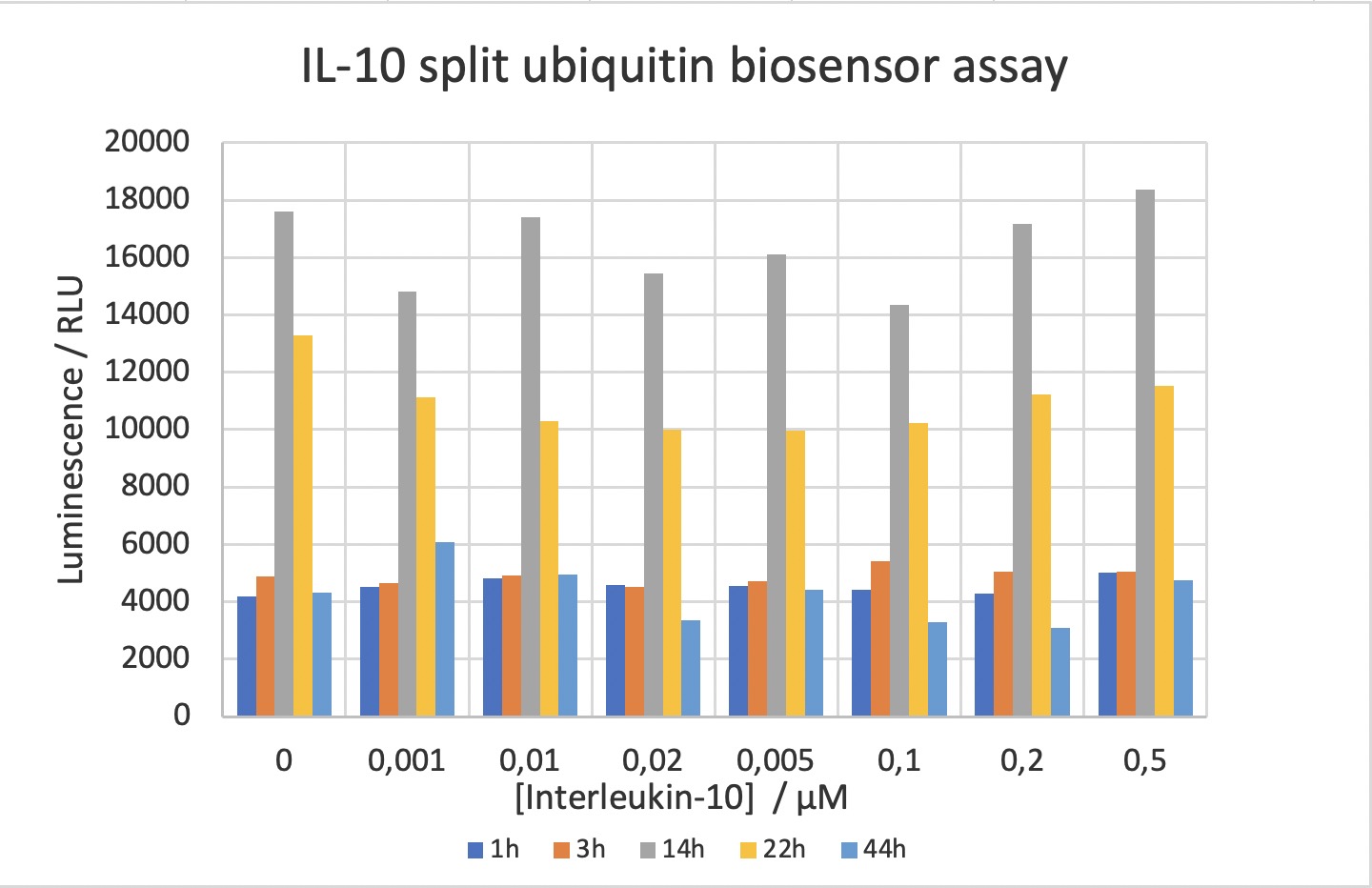Part:BBa_K3617001
sgp130(D1-D3)-Cub
This biobrick is a part of a two-protein system in Saccharomyces cerevisiae which is designed for detection of human interleukin-6 and transduction of the signal by means of a reconstituted ubiquitin. Development of split-ubiquitin as a tool for study of protein-protein interactions in vivo was first published in 1994 and has been an essential feature in biologists’ toolbox ever since (source: https://www.pnas.org/content/pnas/91/22/10340.full.pdf). A specific mutation in the N-terminal part protects it from binding spontaneously to the C-terminal part, however, reassociation can be facilitated by binding of a pair of proteins to which ubiquitin parts are fused. Human signal transducer gp130 was expressed in yeast for the first time in 1997 and further improvements paved the way to our own chimeric transmembrane proteins (source: https://pubmed.ncbi.nlm.nih.gov/9271090/).
Sequence and Features
- 10COMPATIBLE WITH RFC[10]
- 12COMPATIBLE WITH RFC[12]
- 21INCOMPATIBLE WITH RFC[21]Illegal BamHI site found at 1515
- 23COMPATIBLE WITH RFC[23]
- 25COMPATIBLE WITH RFC[25]
- 1000COMPATIBLE WITH RFC[1000]
From N- to C-terminal the protein includes; An endoplasmatic reticulum import signal peptide from the Saccharomyces cerevisiae cell wall integrity and stress response component 1 (Wsc1) receptor in S. cerevisiae, the first three domains of the soluble isoform of human interleukin-6 co-receptor soluble glycoprotein 130 (sgp130), the transmembrane domain from Wsc1, the C-terminal part of the split version of ubiquitin and a synthetic transcription factor LexA-VP16. LexA is a DNA binding domain from Escherichia Coli and VP16 is a transcriptional activation domain from Herpes simplex virus Type 1. Together LexA-VP16 functions as an orthogonal transcription in S. cerevisiae. Between the extracellular sgp130 domains and the transmembrane domain, a (2x)GGGGS-linker was added. Between the transmembrane domain and the C-terminal split ubiquitin domain, two basic amino acids (KR), and the (2x)GGGGS-linker was added.
Sequence optimization
The sequence was codon optimized for S. cerevisiae. The recognition sequences for SpeI, XbaI, NotI, EcoRI, PstI were avoided to follow the RFC10 standard.
Structure and function

figure 2: Both the biobrick and BBalocates to the plasmamembrane. When the receptors trimerize with IL-6 extracellularly, ubiquitin is complemented and the transcription factor in the biobrick is released and triggers expression of the reporter gene.
The signal peptide and transmembrane domain constitute the backbone of the modular framework of the UCopenhagen 2020 team (CIDosis). These are used for localizing the interleukin-1, interleukin-6 and interleukin-10 receptor modules of our biosensors at the plasma membrane of S. cerevisiae as type I single pass transmembrane proteins. As a type I transmembrane protein, the soluble interleukin receptor domains localizes extracellularly while the C-terminal half of the split protein is intracellular. Ivanusic et al. (citation) introduced the use of the signal peptide and transmembrane domain in a split-ubiquitin system for screening for PPIs at the plasma membrane of S. cerevisiae.
The biobrick is intended to work together with BBa_K3617000 which possesses the soluble IL-6 receptor extracellularly and the N-terminal half of split ubiquitin. The biobrick and BBa_K3617000 localizes to the same compartment, the plasma membrane of S. cerevisiae, but will only associate upon presence of IL-6. When IL-6 is present, the extracellular domains of the IL-6R and sgp130 will associate into a heterotrimer consisting of IL-6, IL-6R, and sgp130. When the trimer is formed, the N and C terminal of ubiquitin come together intracellularly. Subsequently endogenous deubiquitinase in the cytosol of S. cerevisiae will cleave off the synthetic transcription factor frem the C-terminal of the reconstituted ubiquitin molecule. Upon complementation of split ubiquitin, the LexA-VP16 transcription factor is cleaved from the C-terminal of ubiquitin and transported into the nucleus where it triggers reporter expression by promoter binding.
Confocal flourescence microscopy
In order to investigate the localization of our protein, superfolding green flourescent protein was linked C-terminally to the protein product of the biobrick and expressed in S. cerevisiae, the cells were observed with confocal flourescence microscopy for visualization.
The majority of investigated cells had either multiple or a single big fluorescent aggregate. This aggregate was positioned between the nucleus and the plasma membrane and can likely be attributed to the presence of inclusion bodies. It is possible that the protein may be stuck in the golgi apparatus, which is especially evident for the cells that had only one accumulation near their nucleus, in accordance to previous findings of Vollmer et al. (year) that have shown that removing the N.terminal Ig-like domain of the IL-6 receptor leads to retention of the protein in the secretory pathway. To circumvent this localization issue, one could add back the N-terminal Ig-domain of the IL6-R.
Biosensor assays
To test the functionality of the part, it was stably transformed into chromosome X site 3 of S. cerevisiae and constitutively expressed by the pTDH3 promoter together with BBa_K3617001. The latter was under constitutive expression by the pPCCW12 promoter. Together, they were also expressed with a NanoBiT luciferase, which luminesces 100 times brighter than firefly or Renilla luciferase(citation). The luciferase expression was conditionally controlled by binding of lexA-VP16 to the lexAop promoter.
After growing the cell cultures to an OD600=0,5, the cells were incubated at 30°C with different concentrations of commercial heterologously expressed IL-6 for 1, 3, 14 and 22 hours. A luminescence assay was performed to analyze the expression of luciferase after application of an industrial extraction reagent called YeastBuster to the samples, which allows for fast extraction of native proteins from yeast without mechanical disruption and enzymatic lysis, mixed with NanoBiT substrate.
No correlation between IL-6 concentration and luminescence intensity was observed at any incubation time. This indicates, that the biosensor does not work as intended for the concentrations and conditions of the experiment.
A similar assay was performed with the IL-10 biosensor strain also developed by the UCopenhagen 2020 team (link to biobricks).
Compared with the IL-10 biosensor, the amount of luminescence was between 3-10 times higher at all concentrations and incubation times for the IL-6 biosensor. This suggests that the two extracellular domains have an affinity to each other even without the presence of IL-6. This further implies that the proteins produced from BBa_K3617000 and BBa_K3617001 are localized at the same subcellular compartments. The protein product of BBa_K3617001 may also be partially degraded, after which the synthetic transcription factor, LexA-VP16, is released and re-localizes to the nucleus. The degradation may take place without any interaction with the protein product of BBa_K361700. One could verify this by integrating only the BBa_K3617001 and reporter gene into S. cerevisiae and performing an additional luciferase assay. Alternatively, one may perform a western blot with primary antibody against GFP on the strain used for the localization assays.
References
[1] Paste reference APA-style here
[2] Paste reference APA-style here
[3] Paste reference APA-style here
[4] Paste reference APA-style here
[5] Paste reference APA-style here
| None |




